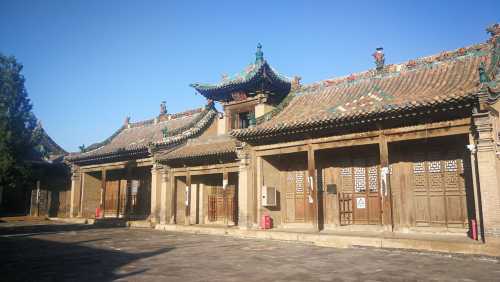App
Customer Support
NZD
Find Bookings
Popular Trip Moments
Shanxi Travel Recommendations | The Magnificent Ancient Cities of Shanxi | Pingyao Ancient City Wall | 2-Day Taiyuan-Jinzhong-Linfen Tour: A Unique Adventure | Jiexiu, Shanxi, China | Pingyao Ancient City: A Journey Through a Thousand Years | A Shanxi Native Recommends This Century-Old Restaurant in Pingyao Ancient City! | Xinzhou Ancient City Private Hot Spring Courtyard | A Millennium Journey of Hot Spring Healing | Unlock the Charm of Shanxi with a Private Car Tour | 6-Day In-depth Tour of Shuozhou and Beyond: A Comprehensive Travel Guide | 5-Day Tour of Xinzhou and Beyond: A Detailed Guide for Every Moment | Follow this guide to unlock the best ways to explore Pingyao Ancient City. | Jiexiu, Shanxi, China | 6-Day Tour of Jinzhong: A Super Detailed Itinerary for a Unique Experience
| Go to Jinzhong during the short holiday - Linfen travel guide, you will understand it immediately after reading it | Cherry Blossom trip to Jinzhong 🌸 | A Generation's Journey to the West: A Three-Day, Two-Night Guide to Datong
| 2-Day Trip to Taiyuan, Jinzhong, and Linfen: A Must-Save Itinerary | A one-day tour of the ancient city Laoqianfeng, the only one in China to be listed as a World Heritage Site | 8-day in-depth tour of Luliang and other places, super detailed guide, save it quickly | Jinzhong-Linfen 4-Day Tour | Super Detailed Guide: Explore Two Cities Without Any Regrets | 25-Day Tour of Sanmenxia and Surrounding Areas: A Super Detailed Itinerary for a Unique Experience | A Super Comprehensive 6-Day Guide to Shuozhou and More! Save It Now! | A Short Holiday Getaway to Taiyuan, Jinzhong, and Linfen: A 2-Day Itinerary | Pingyao Ancient City: A thousand years of history at a glance, hiding the unknown secrets of China | 2,000 Talking Clay Sculptures, Featured on CCTV, the Louvre of the Orient | Explore the Wang Family Courtyard and experience the charm of Shanxi merchant culture. | I thought Datong was impressive enough, until I set foot in Taiyuan… | 10-Day Leisurely Tour of Linfen and Other Areas: Enjoy the Scenery at a Relaxed Pace | Short Holiday Citywalk Guide|Strolling Through Datong and Other Places Is Just Right
Popular Travel Types
Recommended Attractions at Popular Destinations
Bangkok attraction near me | Manila attraction near me | Tokyo attraction near me | Taipei attraction near me | Hong Kong attraction near me | Seoul attraction near me | Kuala Lumpur attraction near me | Los Angeles attraction near me | Shanghai attraction near me | New York attraction near me | Shenzhen attraction near me | Osaka attraction near me | Singapore attraction near me | London attraction near me | Guangzhou attraction near me | San Francisco attraction near me | Beijing attraction near me | Macau attraction near me | Bali attraction near me | Jakarta attraction near me | Paris attraction near me | Ho Chi Minh City attraction near me | Istanbul attraction near me | Phuket attraction near me | Chicago attraction near me | Seattle attraction near me | Toronto attraction near me | Orlando attraction near me | Cebu attraction near me | Chiang Mai attraction near me
Popular Attractions
Shanghai Old Street | Guanyu's Mausoleum | Polynesian Spa | Huangpu River Cruise(Shiliupu Pier) | Humble Administrator's Garden (Zhuozheng Garden) | Penida Island | Xiasi Town | The Peak Tram | Shawan Ancient Town | Xian Banpo Museum | Skyline Rotorua | Yingbinjiu | Rainbow's End | Elephant Jungle Sanctuary Phuket | Prabhodhan Library | Ming Paradise | Rustem Pasha Mosque | Yushui Hot Spring | Gimhae Lotte Water Park | Parco di Peter Pan - Colle Salario | Ionian University Central Library | Keisei-in | Hierapolis ancient theater | La Collina Storta | Đền thờ Trạng nguyên Nguyễn Hiền | Sarovar Park | Congregação Cristã no Brasil, Vila Cruzeiro, Rio de Janeiro, RJ | Pallav Puram Phase II Park-8
Popular Restaurants in Jinzhong
德居源 | Xijiebeibaoke Restaurant | 梁先森·酸奶 | Ren Zai Bei Fang Restaurant | Hong wu ji Hotel | 复兴公饭店 | 客回头小吃 | 醉马蘸片则大全(火车站店) | 我在平遥等你旅行者酒吧(平遥古城店) | 喬家老號餐馆 | Wei Yao Resterount | 湧丰居-又见龙华 | 老介休菜馆(民心小区店) | 呷哺呷哺(天美奥莱杉杉店) | 德克士(介休裕华店) | DE KE SHI XI YANG JIN MEI DIAN | 鱼厂·专注香辣烤鱼(介休店) | Qiaojiazhuangyuan Restaurant | 平遥麒麟阁酒店·颐景四季厅 | 偶遇酒吧(南大街店) | 董记炒碗托·裕成源店 | 喜迎春饭店之三碗不过岗 | Bantianyaoyaokaohuo Fish (wenyuanjie) | 郑记大碗面 | 祥常泰饭店 | 必胜客(中都店) | 云锦成·一醋一面(西大街店) | 池池咖啡馆 | 海岩咖啡(平遥店) | 院里•黔山渔记(榆次店)
Popular Ranked Lists
Top 3 Best Things to Do in Fuzhou | Popular Luxury Hotels in Dhulikhel | Popular Luxury Hotels Near Lazaro Cardenas Municipality | Popular Luxury Hotels Near Fukushima | Top 10 Local Restaurants in Kathmandu | Top 12 Local Restaurants in Akureyri | Top 20 Local Restaurants in Nanchang | Popular Luxury Hotels Near Norwich | Top 3 Luxury Hotels in Tashkent | Popular Luxury Hotels Near East Brunswick | Top 10 Local Restaurants in Canberra | Top 10 Local Restaurants in Riyadh | Top 10 Best Things to Do in Rongcheng | Popular Luxury Hotels in Dhofar | Top 10 Local Restaurants in San Diego | Popular Local Restaurants in Changzhou | Top 5 Best Things to Do in Jingxi | Popular Luxury Hotels Near Fishers | Top 16 Local Restaurants in Hohhot | Top 10 Local Restaurants in Cairns | Top 16 Local Restaurants in Wenzhou | Top 4 Best Things to Do in Changzhi | Popular Luxury Hotels in Kathmandu | Top 10 Local Restaurants in Johor Bahru | Top 10 Local Restaurants in Montreal | Top 8 Local Restaurants in Saipan | Popular Best Things to Do in Lincang | Popular Luxury Hotels Near Jezerce | Popular Best Things to Do in Dongtai | Top 19 Local Restaurants in Guilin
Payment Methods
Our Partners
Copyright © 2025 Trip.com Travel Singapore Pte. Ltd. All rights reserved
Site Operator: Trip.com Travel Singapore Pte. Ltd.
Site Operator: Trip.com Travel Singapore Pte. Ltd.


















